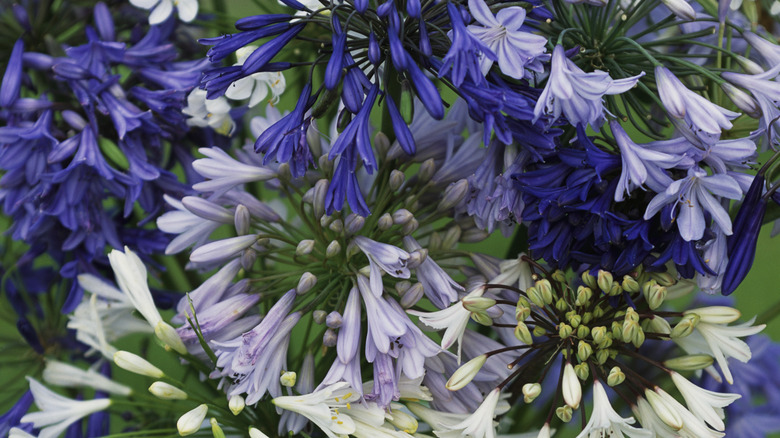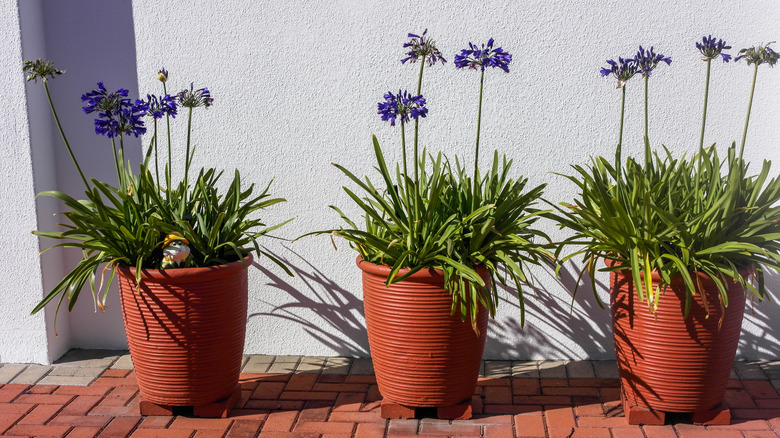What You Need To Know Before Planting Agapanthus Flowers In Your Yard Or Garden
Agapanthus are among the many stunning purple flowers you can grow in your yard, with distinctive flower clusters that rise above the plants' ground cover foliage on tall, straight stems. Also called lilies of the Nile (a misnomer, as they're not from the Nile river region) or African bell lilies, agapanthus originated in South Africa and can weather drought-like conditions well. In addition to their tolerance for drought, agapanthus are tough and versatile plants, growing in anything from partial shade to full sun and bearing up well in a variety of soils, including sandy or clay soils. But as with many plants that thrive in difficult conditions, agapanthus can sometimes become too well-adapted to an area, filling up garden beds over time and even surviving mowing and spraying. They are also considered invasive in certain areas.
This versatility has made the agapanthus genus a popular recommendation for border plantings and other areas where dense, colorful fills might benefit a landscape. There are deciduous and evergreen varieties within the agapanthus family — the deciduous varieties, especially, are recommended alongside other drought-resistant plants — and different species offer different color options, ranging from blue or purple to white. So are agapanthus dream plants, or quickly spreading nightmares? The answer depends on where you're located and which variety you choose.
Consider species and location carefully
Agapanthus are not considered invasive in North America, but they do pose a threat in non-native environments in some areas of the world. In Australia and New Zealand, agapanthus is considered invasive and damaging to native plants. Just as other invasive or aggressive plants do, agapanthus can dominate areas, decrease biodiversity, and seed prolifically in these regions of the world. But not all agapanthus are alike: even in Oceania, sterile varieties of agapanthus such as Black Pantha don't pose a threat to native plants.
One of the reasons that agapanthus clumps can fill out gardens so quickly is that they grow from rhizomes and are easily propagated by both division and seed. This can be a blessing in areas where the plants are not considered invasive, but a curse in areas where agapanthus threaten local wildlife. Even in the U.S., it's worth keeping these qualities in mind before directly sowing agapanthus in your yard or garden: while not winter hardy in all USDA zones, agapanthus are considered perennials and are evergreen in zones 8 through 10, so it's distinctly possible that you'll end up with more agapanthus than you initially bargained for.
Consider container planting instead
One simple way to avoid an unwanted large-scale spread of agapanthus in your yard is to plant agapanthus in containers. There are other advantages to container-gardening agapanthus, too: in hardiness zones where agapanthus cannot be left outside year-round, you can move containers indoors for overwintering and treat agapanthus like a houseplant. As it turns out, container gardening is an ideal method for getting the most blooms possible out of your agapanthus, as they tend to bloom more when slightly rootbound.
Agapanthus typically grows between 2 to 4 feet tall, but there are dwarf varieties such as Baby Blue, Peter Pan, and Lilliput if the prospect of carting a 4-foot-tall plant from outdoors to indoors feels daunting. When moving your agapanthus container indoors for the winter, it's best to allow the soil to dry out between waterings and locate your plant in bright light. Agapanthus can be divided into additional containers every four to five years, or when the roots begin pushing out of the pot.


